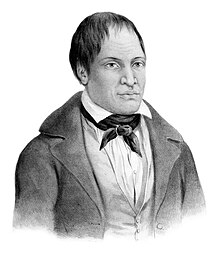| Te Maputeoa Gregorio I | |||||
|---|---|---|---|---|---|
 Drawing of Mapou-Teoa by Jacques Marescot du Thilleul, 1838. | |||||
| King of Mangareva | |||||
| Reign | c. 1830 – 20 June 1857 | ||||
| Predecessor | Te Mateoa | ||||
| Successor | Joseph Gregorio II | ||||
| Born | c. 1814 Te Kehika marae, Rikitea, Mangareva[1] | ||||
| Died | 20 June 1857 Rikitea, Mangareva | ||||
| Burial | 23 June 1857[2] Mausolée du Roi Maputeoa, Chapelle St-Pierre[3] | ||||
| Spouse | Maria Eutokia Toaputeitou, and an earlier wife[4] | ||||
| Issue | Joseph Gregorio II Jean Népomucène[5] Agnès Tepairu[6] Philomèle[6] Catherine[7][8][9] | ||||
| |||||
| Father | Te Ikatohara | ||||
| Mother | Puteoa[1][9] | ||||
| Religion | Mangarevan Roman Catholicism | ||||
| Signature | |||||


Te Maputeoa (baptized Gregorio Stanislas; reigned as Gregorio I; born c. 1814 – 20 June 1857) was a monarch of the Polynesian island of Mangareva and the other Gambier Islands. He was the King or ʻAkariki (paramount chief),[10][11] as well as the penultimate king of the island of Mangareva, and other Gambier Islands including Akamaru, Aukena, Taravai and Temoe. He reigned from 1830 until his death in 1857.[12][13]
During Maputeoa's reign, the country, which was deeply rooted in native beliefs and even cannibalism, became a Roman Catholic community. This was accomplished by removing all vestiges of native beliefs, such as destroying the traditional wooden images of their indigenous faith deified in maraes and replacing them with churches. The king was baptized into Catholicism on 25 August 1836.[14] He learned about Christianity from the island's missionaries, headed by the French Picpus priests, Honoré Laval and François Caret. His uncle Matua, the High Priest of the local temple, also played a pivotal role in this activity.[13][15]
- ^ a b Bernice P. Bishop Museum Bulletin, Issues 154-159. Honolulu: Bernice P. Bishop Museum. 1938. p. 91. OCLC 263591812.
- ^ Cuzent 1872, p. 127.
- ^ "Mausolée du Roi Maputeoa". Tahiti Heritage. Archived from the original on 23 July 2018. Retrieved 20 June 2015.
- ^ Lesson 1846, pp. 183–185.
- ^ Laval, Newbury & O'Reilly 1968, p. 656.
- ^ a b Deschanel 1888, pp. 59–60.
- ^ Laval, Newbury & O'Reilly 1968, p. 343.
- ^ Cuzent 1872, pp. 52–53.
- ^ a b Laval, Newbury & O'Reilly 1968, pp. cxxxvi–cxxxix.
- ^ Kjellgren 2007, p. 294.
- ^ Smith 1918, pp. 130–131.
- ^ Cahoon, Ben (2000). "French Polynesia". WorldStatesman.org. Worldstatesman organization. Archived from the original on 23 July 2018. Retrieved 21 June 2015.
- ^ a b The Dublin Review, Vol. IV 1838, pp. 372–73.
- ^ Kerchache 2001, p. 309.
- ^ Garrett 1982, p. 94.